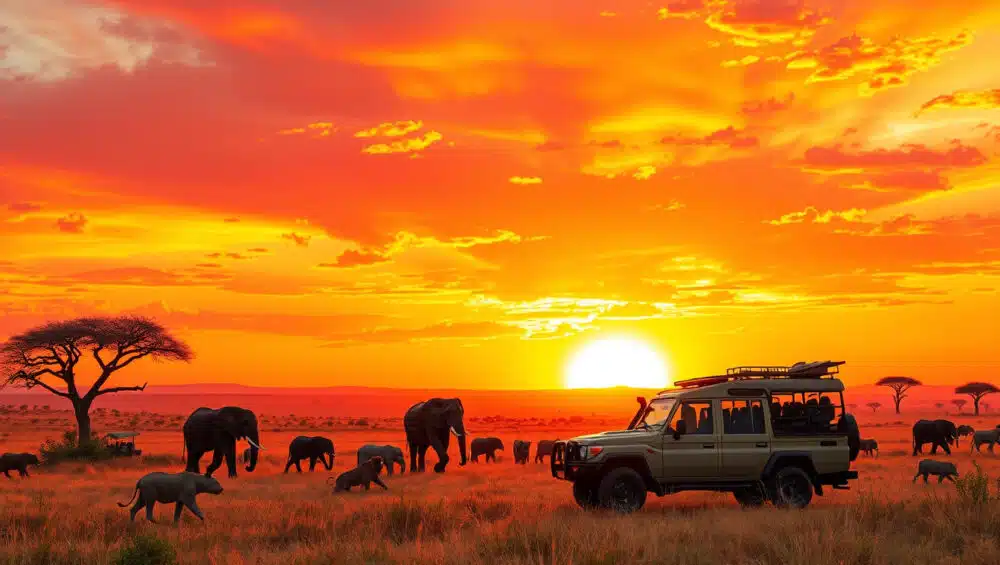Embarking on a safari is a bucket-list experience for many travelers, offering a chance to immerse oneself in the breathtaking landscapes and remarkable wildlife of East Africa. However, planning a safari can feel overwhelming, especially for first-timers. In this comprehensive guide, we will explore essential insights and practical tips to help you create the perfect adventure. From understanding the unique safari experience to selecting the right destination and time to visit, this first-timer’s guide to planning a safari in East Africa covers all the bases to ensure you make the most of your journey into the wild.
Key Takeaways
- A safari is a unique experience that combines adventure with wildlife observation.
- East Africa offers a variety of destinations, each with breathtaking landscapes and diverse wildlife.
- The ideal time for a safari varies by region, affecting animal visibility and weather conditions.
- Planning your itinerary and accommodations is crucial for a seamless safari experience.
- Packing essentials and knowing wildlife viewing tips enhance your trip and photography opportunities.
Understanding the Safari Experience
Planning a safari in East Africa can be an exhilarating yet overwhelming experience, especially for first-timers. To help you navigate this incredible journey, A First-Timer’s Guide to Planning a Safari in East Africa is essential reading. East Africa is renowned for its breathtaking landscapes, diverse wildlife, and rich cultural heritage, making it the perfect location for your safari adventure. Understanding the nuances of the safari experience is crucial. From deciding the best time to visit—typically during the dry season when animals congregate near water sources—to selecting the right national parks, such as the Serengeti or Maasai Mara, every detail matters. Booking knowledgeable guides can enhance your experience significantly, ensuring you get the most out of your wildlife sightings while respecting the natural habitat. Moreover, consider whether you prefer a luxury lodge, a tented camp, or a more budget-friendly option, as accommodations vary widely and can greatly influence your overall experience. Following A First-Timer’s Guide to Planning a Safari in East Africa will not only ease the planning process but also enrich your safari journey, making it a memorable adventure in one of the world’s most enchanting destinations.
Choosing the Right Destination
When embarking on an adventure in East Africa, choosing the right destination is pivotal for a memorable safari experience. A First-Timer’s Guide to Planning a Safari in East Africa emphasizes the need to consider various factors such as wildlife diversity, the best time to visit, and accessibility. For instance, Tanzania‘s Serengeti National Park is renowned for its astonishing wildlife migration in July and August, while Kenya’s Maasai Mara offers an immersive cultural experience alongside thrilling game drives. Additionally, locations like Amboseli National Park provide breathtaking views of Mount Kilimanjaro and unique opportunities to see elephants up close. By narrowing down your preferences and understanding what each destination offers, you can tailor your safari itinerary to ensure an unforgettable experience that perfectly matches your adventurous spirit.
‘In every walk with nature one receives far more than he seeks.’ – John Muir
Best Time to Visit East Africa for a Safari
When planning a safari in East Africa, timing is everything. The region boasts diverse ecosystems that vary significantly throughout the year, making it essential for first-timers to understand the best times to visit. Generally, the dry season from June to October is considered the ideal period for a safari, as wildlife congregates around water sources, making animal sightings more frequent and easier. This is also the time when the Great Migration occurs in the Serengeti, where millions of wildebeest and zebras traverse the plains in search of greener pastures. However, the wet season, from November to May, can also be advantageous, as the lush landscapes are picturesque, and many animals give birth during this time, leading to tender moments that are perfect for capturing on camera. Ultimately, understanding the seasonal variations will enhance your experience, allowing you to plan effectively and maximize your time in this breathtaking wilderness. Thus, whether you choose to visit during the peak season or the rainy periods, being mindful of these factors will ensure that you create unforgettable memories on your East African safari.
Planning Your Itinerary and Accommodations
Planning your itinerary and accommodations is a crucial step in ensuring that your safari experience in East Africa meets your expectations. As a first-timer, it’s essential to consider various factors that will enhance your journey. Start by researching the best times to visit, as wildlife viewing can vary dramatically depending on the season. Popular destinations such as the Serengeti in Tanzania and the Maasai Mara in Kenya offer spectacular game-watching opportunities, particularly during the Great Migration, which typically takes place from June to October. When it comes to accommodations, East Africa offers a range of options, from luxury lodges to budget-friendly camps. Booking ahead is advisable, especially during peak tourist seasons, to secure the best spots. Additionally, consider the type of safari you prefer—whether it’s a guided tour, self-drive experience, or a combination of both—and choose your accommodations accordingly. With careful planning and the right resources, your safari adventure will not only be unforgettable but also an ideal introduction for first-timers seeking the wild allure of East Africa.
Essential Packing List for a Safari
When embarking on a safari, especially for the first time in East Africa, having the right gear is crucial to ensure a memorable and comfortable adventure. This essential packing list covers everything you need in your suitcase, from clothing to travel documents, making it an invaluable resource in A First-Timer’s Guide to Planning a Safari in East Africa. Start with breathable, lightweight clothing in neutral colors to blend with the landscape and avoid drawing unnecessary attention to wildlife. A wide-brimmed hat and sunglasses will protect you from the sun, while a good pair of binoculars will enhance your game viewing experience. Don’t forget a sturdy pair of walking shoes for those occasional treks and a light jacket for cooler evenings. Additionally, consider bringing insect repellent, sunscreen, personal medications, and a reusable water bottle to stay hydrated while minimizing waste. Packing a camera with a zoom lens to capture those unforgettable moments is also essential. By checking off these items in your safari packing list, you’re well on your way to enjoying the breathtaking beauty of East Africa like a pro.
Tips for Wildlife Viewing and Photography
For those embarking on a safari in East Africa, capturing stunning wildlife photographs can be a highlight of your adventure. A First-Timer’s Guide to Planning a Safari in East Africa emphasizes the importance of preparation, starting with choosing the right time of year to visit, as many animals will be easier to spot during migration seasons. Bring along a quality camera with a good zoom lens to capture distant animals in detail, and consider investing in a sturdy tripod to keep your shots steady. Wildlife Viewing and Photography Tips should also include advice on being patient; the best moments in nature often require stillness and quiet observation. Dress in neutral colors to blend into the surroundings, minimizing disturbances to the wildlife. Understanding animal behavior can enhance your photography experience; for instance, knowing when animals are most active helps you position yourself for the perfect shot. Finally, don’t forget to have fun and enjoy the experience, as the thrill of wildlife viewing is just as meaningful as the photographs you take.






